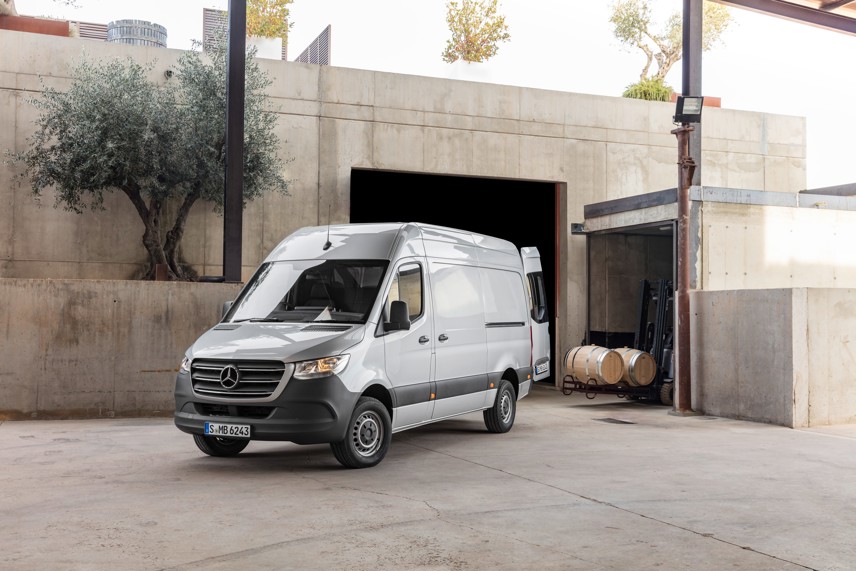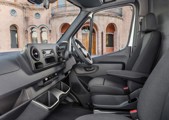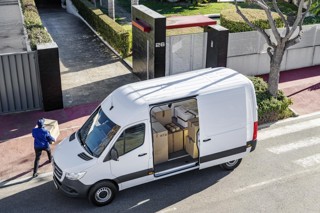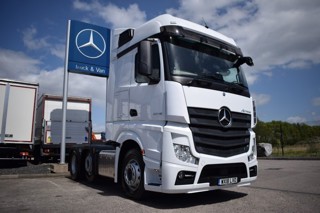Review
New vans are relatively rare when compared to launches in the car sector.
A proliferation of co-developed vehicles to help reduce cost, and longer lifecycles mean the next generation of a van is always worthy of a fanfare.
The new Sprinter brings with it some big changes, including, for the first time, a front-wheel drive version, lowering the entry point to the range, and allowing the van to compete on price with front-wheel drive rivals.
There are now more than 1,700 possible variants encompassing all possible body and powertrain options.
New front-wheel drive increases payload by 50kg (thanks to the absence of a driveshaft running along the length of the van to the rear wheels) and also offers an 80mm lower sill for easier loading and access.
All come with six-speed manual transmission as standard. The front-wheel drive version is offered with a new nine-speed automatic transmission, while rear-wheel drive and four-wheel drive models come with a seven-speed gearbox when automatic is selected.
For the Sprinter variants with a diesel engine and rear-wheel drive, maintenance intervals are up to 37,000 miles or two years, while front-wheel drive versions require a service after a maximum of 24,500 miles or two years.
Engines are carried over from the outgoing Sprinter, although there is slightly more power available.
The four-cylinder 2.1-litre comes with outputs of 114PS, 143PS and 163PS, while the front-wheel drive version has a higher-output third variant of 177PS, reserved exclusively for the camper van sector.
There is also a six-cylinder 3.0-litre option with 190PS, up from 184PS in its predecessor.
Mercedes-Benz says using existing engines is a lower risk strategy than launching a new van with new engines, giving the likelihood of fewer teething problems to iron out.
And the vehicle was able to comply with all current emissions legislation with the older engine.
Prototypes with all engine and transmission variants underwent test cycles totalling almost six million miles in eight locations in four countries, from intense cold in Finland and high altitudes in the Andes to extreme heat in the United States.
But Mercedes-Benz’s new 2.0-litre four-cylinder engine, already being rolled out in its car range since 2015, with advanced exhaust after-treatment capability, will replace the 2.1-litre engine during the new Sprinter’s lifecycle, most likely when tougher real driving emissions (RDE) tests are introduced measuring cold running from 2021.
For the new Sprinter, Mercedes-Benz is introducing more than just a van.
In response to operators seeking greater ability to manage their vehicles remotely, a new connected telematics system, called Mercedes Pro Connect, is being launched with the van.
The basic system will be standard, with operators able to buy up to eight additional elements as bolt-ons, including Vehicle Supervision, Vehicle Operations, Fleet Communication, Maintenance Management and Accident Management plus a Digital Driver Log.
Vehicle Supervision displays all relevant data as well as the usage over a defined period. Vehicle Operations accesses vehicle location and has a geofencing function.
Vehicle Management Tool sends messages, addresses or contact details to the Mercedes Pro Connect app and enables information about forthcoming servicing to support maintenance management.
A high-speed internet connection is available for the connectivity services of Mercedes Pro Connect, but can also act as a hot spot for separate mobile devices.
For the first three years, the Mercedes Pro service Live Traffic is available free with the navigation system.
Mercedes-Benz plans to roll out Mercedes Pro Connect on other vans in its range with future updates, as well as working to accommodate LCVs of other makes on a customer’s fleet so they would be able to manage and monitor all of them through the same system.
During our test drive in the Netherlands, we were assigned a task which we received through Mercedes Pro Connect, with navigation instructions to the collection point immediately programmed automatically on acceptance of the job.
The van is also available with the Mercedes-Benz new user interface (MBUX), revealed earlier this year in the A-Class hatchback, making the Sprinter only the second Mercedes-Benz model to feature it.
Our test vehicles all included this option, as well as the 10.25-inch dashboard touchscreen, although we expect most customers will keep the standard seven-inch one.
But the optional, larger screen looks modern and sophisticated, while the voice control system is good at recognising natural phrases and speech patterns.
The Sprinter makes driving feel effortless, especially when fitted with the optional automatic gearbox.
Noise intrusion is remarkably low and the controls are light and easy to use.
Optional safety features have been developed further for the new Sprinter, with Active Distance Assist Distronic celebrating its premiere, allowing the driver to set the desired speed from 12mph upwards.
The system automatically maintains an adequate safety distance from the vehicle ahead.
Model tested: Mercedes-Benz Sprinter 314 CDI L2 H1 FWD






















Login to comment
Comments
No comments have been made yet.